I’m thrilled to share why Kemper cabinets should be your go-to choice for transforming your kitchen or bathroom. With their blend of style, durability, and customization, Kemper offers something special for every home.
Whether you’re remodeling or building from scratch, these semi-custom cabinets deliver quality and charm at a price that won’t break the bank. From timeless designs to modern functionality, Kemper has earned its spot as a trusted name.
Let’s explore my journey with Kemper and why I think you’ll love them as much as I do.
My Journey With Kemper Cabinets
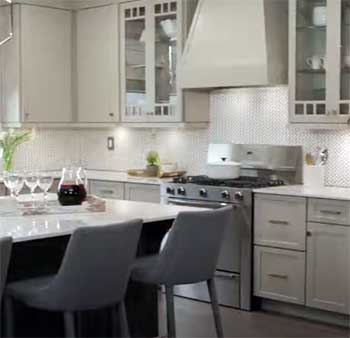
Picture this: I’m standing in my outdated kitchen, dreaming of a space that feels fresh, functional, and mine.
My old cabinets were chipped, creaky, and screaming 1980s vibes—not in a cool, retro way.
I wanted something that could handle my chaotic cooking sessions, look stunning, and fit my budget.
After weeks of research, I landed on Kemper cabinets, and let me tell you, it was a game-changer.
I chose Kemper’s Emerge series in a sleek maple finish with a soft gray glaze. The moment the delivery truck arrived, I felt like a kid on Christmas morning.
The cabinets were packed meticulously, and the installation process was smoother than I expected, thanks to my contractor’s expertise. What struck me first was the weight of the doors—solid, sturdy, and reassuring.
Opening them felt like unwrapping a gift, revealing thoughtful storage solutions like pull-out trays and deep drawers that made my pots and pans feel organized for the first time.
Using Kemper cabinets daily has been a joy. The soft-close hinges are a small but life-changing detail—no more slamming doors waking the house!
The finish holds up beautifully, even after my infamous marinara sauce splatter incident. I went with semi-custom options, tweaking the cabinet heights to fit my tall ceilings and adding a pantry pullout that’s now my favorite feature.
It’s been a year, and I’m still obsessed with how these cabinets make my kitchen feel both luxurious and practical. Kemper didn’t just meet my expectations; it exceeded them, turning my kitchen into the heart of my home.
Pros of Kemper Cabinets
- Customization That Fits Your Vision
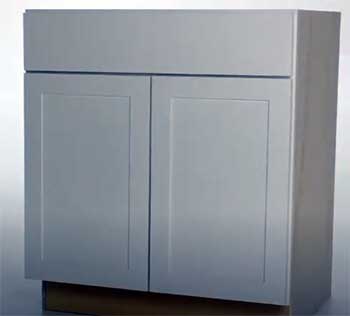
One of the biggest reasons I fell for Kemper is their semi-custom approach.
You get to play designer without the jaw-dropping price tag of full custom cabinets.
With over 60 door styles and 144 finishes, I could mix and match to create a look that screamed me.
I chose a modern slab door for my kitchen’s clean aesthetic, but if you’re into classic raised panels or rustic distressing, Kemper’s got you covered.
You can adjust cabinet depths, heights, and even add unique features like glass-front doors or built-in spice racks. It’s like building your dream kitchen with a safety net of affordability.
- Quality That Holds Up
I’m tough on my kitchen—think daily cooking, kids grabbing snacks, and the occasional “oops” moment with a heavy skillet. Kemper cabinets are built to take a beating. The furniture board used in their standard construction is surprisingly durable, and I upgraded to plywood sides for extra strength.
The dovetail drawers glide smoothly even when stuffed with heavy cookware, and the solid wood face frames feel like they’ll last forever. Kemper’s limited lifetime warranty gave me peace of mind, knowing they stand behind their craftsmanship.
After a year of heavy use, my cabinets still look brand-new.
- Thoughtful Storage Solutions
If you’re like me, you’ve got a million kitchen gadgets that need a home. Kemper’s storage options are a lifesaver. I added a base container organizer for my pantry, and it’s a revelation—every can and box is easy to find.
The pull-down shelves in my upper cabinets make grabbing dishes a breeze, even for my vertically challenged friends. Kemper thinks about how you actually use your space, offering roll-out trays, lazy Susans, and hidden message centers.
These features make my kitchen feel like it was designed by someone who gets my daily routine.
- Eco-Conscious Manufacturing
I care about the planet, and Kemper’s commitment to sustainability was a pleasant surprise. They’re part of the Kitchen Cabinet Manufacturers Association’s Environmental Stewardship Program, using low-emission coatings and recycling waste.
Knowing my cabinets were made with environmentally responsible materials made me feel good about my choice. It’s not just about looks; it’s about making a purchase you can stand behind ethically.
- Affordable Luxury
Let’s talk money. I didn’t want to empty my savings for a kitchen remodel, but I also didn’t want cheap cabinets that would fall apart. Kemper hits that sweet spot. Their mid-range pricing feels like a steal for the quality and customization you get.
Compared to high-end brands, I saved thousands without sacrificing style or durability. Kemper’s range of series—Echo, Choice, and Emerge—lets you pick what fits your budget while still delivering a premium look.
Not-So-Good Parts of Kemper Cabinets
- Inconsistent Delivery Times
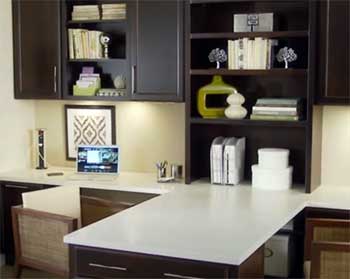
I’ll be honest: the wait for my Kemper cabinets tested my patience.
I was quoted 4-6 weeks, but part of my order arrived in 3 weeks, while the rest trickled in at 8 weeks.
It threw off my contractor’s schedule, and we had to pause the remodel.
I’ve heard similar gripes from others, with some waiting up to 16 weeks for their full order.
If you’re on a tight timeline, this unpredictability can be a headache. My advice? Plan for delays and confirm delivery schedules with your dealer upfront.
- Finish Imperfections
While my cabinets arrived in great shape, I’ve read reviews from folks who weren’t as lucky. Some reported small cracks, chips, or uneven paint finishes, especially on lighter colors.
My gray-glazed maple cabinets have held up well, but I noticed a tiny flaw in one door’s glaze that I only spotted under bright light. Kemper offered to replace it, but I decided it wasn’t worth the hassle. If you’re picky about perfection, inspect every piece upon delivery and don’t hesitate to use their warranty.
- Thinner Base Material
I opted for the plywood upgrade, but Kemper’s standard cabinets use 3/8-inch furniture board for bottoms, which feels a bit flimsy. My contractor warned me that small screws for under-cabinet lighting could pierce through if not installed carefully.
I’ve had no issues, but if you’re not upgrading to plywood, be mindful of this. It’s not a dealbreaker, but thicker materials in competitors’ standard lines might give you more confidence.
- Dealer Dependency
Your experience with Kemper can depend heavily on your dealer. My local supplier was fantastic, guiding me through customization and handling issues promptly.
But I’ve heard horror stories about less reliable dealers—wrong orders, poor communication, or delays in addressing warranty claims. If you’re considering Kemper, research your dealer thoroughly. A good one makes all the difference; a bad one can sour the experience.
Maintenance Tips For Kemper Cabinets
- Regular Cleaning for Lasting Shine
Keeping your Kemper cabinets looking pristine is easier than you think. I clean mine weekly with a soft, damp cloth and mild dish soap diluted in water. Avoid harsh chemicals like bleach or ammonia—they can strip the finish.
For stubborn grease spots from my cooking adventures, I dab a bit of vinegar on a microfiber cloth, and it works like magic. Dry immediately to prevent water spots, especially on darker finishes. This routine keeps my cabinets gleaming and prevents buildup that could dull their charm over time.
- Preventing Yellowing on Light Finishes
If you’ve chosen white or light-colored Kemper cabinets, yellowing can be a concern, especially in kitchens with lots of cooking. I learned this the hard way when a corner of my old white cabinets started to yellow from grease and smoke.
To prevent this with my Kemper cabinets, I wipe them down regularly and use a range hood religiously when cooking. A yearly deep clean with a baking soda paste (1 part baking soda, 2 parts water) helps remove any sneaky buildup. Keep an eye on areas near the stove—they’re the most prone.
- Handling Scratches and Dings
Life happens, and so do scratches. I accidentally nicked a cabinet door with a knife during a rushed dinner prep. Kemper’s warranty covers major damage, but for minor scratches, I use a touch-up marker in a matching color, available from my dealer.
For deeper dings, a bit of wood filler and a quick sand does the trick. Always test products in a hidden spot first. If you’re not handy, Kemper’s customer service can guide you or send replacements for significant issues.
- Maintaining Hardware and Mechanisms
The soft-close hinges and drawer glides on my Kemper cabinets are a dream, but they need a little love to stay smooth. Every six months, I vacuum out dust from the tracks and wipe them with a dry cloth.
For sticky glides, a drop of silicone-based lubricant (not WD-40, which attracts grime) keeps things gliding like new. Check screws on handles and hinges annually—tighten any loose ones to prevent wobbling. This small effort keeps your cabinets feeling luxurious for years.
- Protecting Against Moisture
Kitchens and bathrooms are moisture magnets, and even high-quality cabinets like Kemper’s can suffer if you’re not careful. I learned to wipe up spills immediately, especially near the sink. During humid summers, I use a dehumidifier to keep moisture levels in check.
For bathroom vanities, ensure proper ventilation with an exhaust fan. If you notice any warping or swelling (rare with Kemper’s materials), contact their support team right away—they’re quick to address warranty claims.
Comparison of Kemper Cabinets With Other Brands
I looked at several brands before settling on Kemper, and Homecrest, Koch, and Marsh Cabinets were high on my list.
Here’s how Kemper stacks up against each, based on my research and hands-on experience, to help you decide what’s best for your kitchen.
- Kemper Vs. Homecrest Cabinets
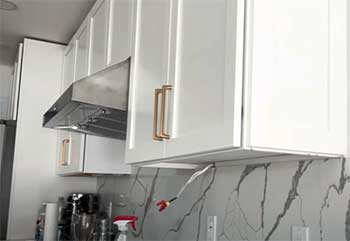
Homecrest caught my eye with its budget-friendly pricing and modern designs.
Their Momentum series has a sleek, frameless look that’s perfect if you love a minimalist vibe.
I was tempted, but Homecrest’s customization options are more limited—around 40 door styles compared to Kemper’s 60+.
Kemper’s semi-custom flexibility let me tweak cabinet heights and add a pantry pullout, which Homecrest couldn’t match. Homecrest uses particleboard as standard, similar to Kemper’s furniture board, but their plywood upgrade is pricier.
Durability-wise, both held up well in reviews, but Kemper’s solid wood face frames and dovetail drawers felt sturdier to me. Homecrest’s lead times were more consistent, averaging 4-5 weeks, but I preferred Kemper’s storage solutions and broader style range for my busy kitchen.
- Kemper Vs. Koch Cabinets
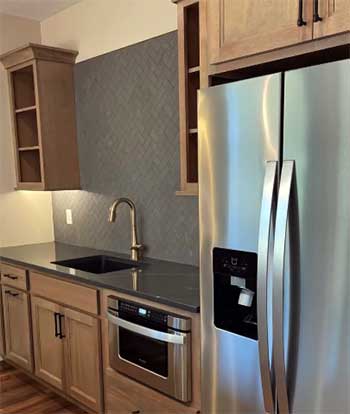
Koch Cabinets, a smaller brand, focuses on custom and semi-custom options with a reputation for craftsmanship.
Their Classic line offered raised-panel doors that rivaled Kemper’s traditional styles, and their all-plywood construction as standard impressed me.
However, Koch’s pricing was a notch higher—about 20% more than Kemper for similar features.
I loved Koch’s attention to detail, like hand-applied glazes, but Kemper’s 144 finish options gave me more room to play.
Koch’s storage accessories, like roll-out trays, felt less innovative than Kemper’s pull-down shelves and container organizers.
Delivery was another factor: Koch quoted 8-10 weeks, longer than Kemper’s average. For me, Kemper’s balance of cost and customization won out, but Koch is a strong pick if you prioritize bespoke quality and don’t mind the splurge.
- Kemper Vs. Marsh Cabinets
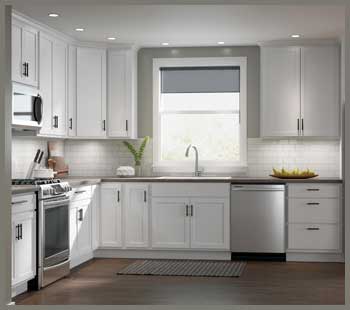
Marsh Cabinets, known for affordability, was a contender for my budget-conscious side.
Their Heritage series had solid wood doors and a decent range of 45 finishes, but the customization was bare-bones compared to Kemper.
I couldn’t adjust cabinet depths or add unique features like Kemper’s hidden message center.
Marsh uses particleboard with a melamine interior, which felt less durable than Kemper’s furniture board or plywood upgrade.
On the plus side, Marsh’s pricing was 10-15% lower, and their delivery was reliable at 3-4 weeks. But their warranty is only five years, compared to Kemper’s limited lifetime. For my family’s rough-and-tumble kitchen, Kemper’s durability and storage options were worth the slightly higher cost over Marsh’s no-frills approach.
Frequently Asked Questions (FAQ)
Absolutely, Kemper cabinets are solid for the price. Their standard construction uses durable furniture board, with plywood upgrades available for extra strength. The dovetail drawers, soft-close hinges, and solid wood face frames hold up well under daily use—I’ve had no issues after a year of heavy cooking. Their limited lifetime warranty is a testament to their confidence in the product. That said, some users report minor finish flaws, so inspect your order carefully. For a mid-range brand, Kemper delivers quality that rivals pricier competitors.
Kemper is manufactured by MasterBrand Cabinets, Inc., the largest residential cabinet maker in North America. Based in Indiana, MasterBrand also owns brands like Diamond and Schrock. Since acquiring Kemper in 1998, they’ve kept the brand’s focus on semi-custom, mid-range cabinets with a reputation for durability and style. MasterBrand’s scale means Kemper benefits from advanced manufacturing and a wide range of design options.
Not quite, but they’re close cousins. Both Kemper and Diamond are MasterBrand brands, sharing similar materials like furniture board or plywood and offering semi-custom options. However, their door styles, finishes, and series differ. Kemper has a broader range (60+ door styles vs. Diamond’s 50), while Diamond’s finishes sometimes feel a bit more refined. I chose Kemper for its storage solutions, but Diamond’s a strong alternative if you prioritize polish over customization.
Kemper’s standard cabinets use 3/8-inch furniture board for sides and bottoms, with 3/4-inch furniture board shelves and solid wood face frames. You can upgrade to plywood for added durability, which I did for my kitchen. Door options include solid woods like maple, cherry, oak, or hickory, plus laminates and thermofoil for budget-friendly styles. The 12-step finishing process ensures a smooth, lasting look. My maple cabinets feel sturdy and look fantastic, even with daily wear and tear.
Conclusion: Why Kemper Cabinets Are A Smart Choice?
After living with Kemper cabinets, I can confidently say they’re worth every penny. They blend style, durability, and customization in a way that feels like a steal for the price. From their thoughtful storage to their eco-friendly manufacturing, Kemper makes your space feel personal and practical.
If you want a kitchen or bathroom that wows without draining your wallet, Kemper’s the way to go. Trust me—you’ll love the way these cabinets transform your home.
